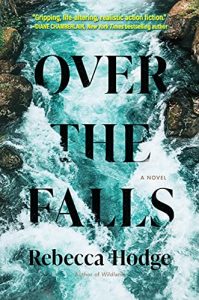The Zigzag Path of Writing a Novel – Rebecca Hodge
 The writing universe abounds with how-to advice: write daily, write on-the-fly, plan everything, plan nothing, be sure to buy a special pen, a special notebook, the one and only brand of tea. The only thing we can all agree on is the fact that there’s no one-size-fits-all pathway to creating a novel, and indeed, what works for one book may not work for the next.
The writing universe abounds with how-to advice: write daily, write on-the-fly, plan everything, plan nothing, be sure to buy a special pen, a special notebook, the one and only brand of tea. The only thing we can all agree on is the fact that there’s no one-size-fits-all pathway to creating a novel, and indeed, what works for one book may not work for the next.
Granting that diversity, I’m here to sketch out the approach that seems to be working for me—at least at the moment—in the hope that you may find something helpful here. So for what it’s worth, here goes.
Pre-writing work: I’ve written multiple full manuscripts—some published, some not—without doing any planning before sitting down to write. This can work. I’ve made it work. But my left-brained self has grown increasingly dismayed at how inefficient this approach can be. Meaningless scenes and pointless characters invariably lead to vast amounts of wasted time—both to create the stuff to begin with and then to get rid of it.
As a result, I’ve evolved into a seat-of-the-pants writer who nonetheless does some basic planning before starting to write. I like Jennie Nash’s ‘Inside Outline’, in which the basics of the story are sketched out in only two or three pages, with each plot event associated with the impact of that event on the main character.
I overlay this sketch with the ‘beats’ that form the backbone of ‘Save the Cat Writes a Novel’. I do not expect this planning document to be a work of perfection, and I end up with a few placeholder statements like ‘something major needs to happen here,’ but once I’ve framed up this document, I at least have a general idea of who’s on stage and where my story is headed.
With this rough plan in place, it’s time to settle into the actual work, which I think of in three phases.
Phase 1: Get the words on the page.
In this phase, the goal is to create a rough draft that moves the full way through the story. Ideally, this phase is writing, not revising—just make notes when you realize you’re going to have to go back and change something. (Yeah, okay, I admit I do at least a single-pass revision as I finish each chapter, because I can’t help myself, but YOU can do better.) In this phase, daily or weekly word-count goals may make sense for some people—they definitely help me stay on track.
Phase 2: Revise for structure.
This is the phase where my inner geek comes out to play. Now that I’ve got three hundred pages of stuff, I map it out in detail. I do this in Excel (the members of my writing group cringe whenever they hear this), detailing each chapter: its length, characters on the page, key events, key backstory, things that I realize are missing. I return at this point to the ‘Save the Cat’ beats (Are they there?
Are they in the right place?), and although I’m not quite geeky enough to be a true ‘Story Grid’ disciple, I do often look back through my Story Grid notes and see whether they lead me to further discoveries. In this phase, it’s mainly big issues that get addressed—Do I need all these characters? Is the pace okay throughout? Should the climax occur later?—but I fix minor issues along the way if I trip over them. For this phase (and the next), I don’t find word count goals helpful, but I do set myself ‘butt-in-chair’ time goals.
Phase 3: Edit.
In theory, I’ve now got the words on the page and a story that’s structured in a sensible manner. Now it’s time to polish it up. At this point, I’ve gone through the full manuscript multiple times, and if I’m aware of major weak points, I tackle them first. For me, this often means trying to deepen individual characters—I’m a ‘plot first/ characters second’ writer.
Then it’s a page-by-page, chapter-by-chapter edit –Does the dialog feel right? Is there too much description? Is there enough tension in every scene? Is this the right word? Be sure to check out ‘Intuitive Editing’ by Tiffany Yates Martin for help along the way. When I’m done—or am trying to convince myself I’m done–my last step is to edit the pages in random order. I’m consistently amazed at how much I pick up this way—it lets me focus on words and sentences without getting caught up in the forward flow of the story.
Phase 3B: Let it sit.
Yes, I know—I promised three phases—but this one’s also important. Once you’re ‘done,’ if you aren’t pressed by a deadline, set the manuscript aside and spend a week, a month, two months, working on something else. Then come back to it. You may be surprised at what new revelations become apparent—and you want those good ideas incorporated before you submit to your dream agent or reach out to a new publisher.
And there you have it. A ‘final’ manuscript—at least final until you get notes from your beta readers, agent, editor, etc. Is it as easy as this makes it sound? No. Will you follow this pattern religiously and discover it is ideal for you? I highly doubt it. But I hope there may be small pieces of this zigzag pathway that will resonate. Good luck and let me know how it goes!
—
Rebecca Hodge is an author of fiction, a veterinarian, and a clinical research scientist who lives and writes in North Carolina. Fiction writing is the space where her creative side comes out to play, and her writing centers on characters who discover that life is not a spectator sport. She has three grown sons, two crazy dogs, and one patient husband. When not writing on the back porch or brewing yet another mug of tea, she loves hiking, travel, and (of course) curling up with a good book.
Rebecca Hodge’s debut novel WILDLAND has received rave reviews from readers and was selected by Apple Books for their ‘Best of the Year So Far’ list.
Find out more about Rebecca on her website https://www.rebeccahodgefiction.com/
Follow her on Twitter https://twitter.com/rhodgefiction
OVER THE FALLS, Rebecca Hodge
 For fans of The River at Night, Rebecca Hodge’s next thrilling read explores how far one woman will go to find her sister.
For fans of The River at Night, Rebecca Hodge’s next thrilling read explores how far one woman will go to find her sister.
Bryn Collins moved to the Eastern Tennessee mountains and never looked back when, fourteen years ago, her fiancé, Sawyer, jilted her for her despised sister, Del. Sawyer was later killed in a plane crash, but Bryn has never been able to forgive her sister for what she did, and instead chooses to spend her days in the idyllic beauty of the rugged landscape. Although a life-threatening accident ended her days navigating the perils of whitewater, she still finds refuge kayaking in the local lakes.
But Bryn’s placid life hits the skids when an unwelcome cast of characters reenters her life. Del goes mysteriously missing, leading her fourteen-year-old son, Josh, to Bryn’s doorstep for help. Then Carl, a trouble-making outcast the sisters knew years before, is desperate to find Del because she owes him money, pulling Bryn into the orbit of his schemes.
On the hunt for Del, Bryn and Josh follow an ever-elusive trail to Colorado, and at the annual Mountain Games competition in Vail, they finally confront the truth. For Bryn, all roads lead to the river, and on vicious Colorado whitewater, she is forced to muster every ounce of courage and strength she has to piece her family back together again.
BUY HERE
Category: How To and Tips






























